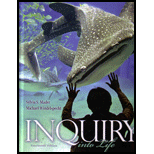
Inquiry into Life
14th Edition
ISBN: 9780073525525
Author: Mader, Sylvia S./
Publisher: McGraw-Hill College
expand_more
expand_more
format_list_bulleted
Concept explainers
Textbook Question
Chapter 35.1, Problem 2CYP
Explain why most energy fails to be converted to a usable form when one organism eats another.
Expert Solution & Answer
Want to see the full answer?
Check out a sample textbook solution
Students have asked these similar questions
The following table is from Kumar et. al. Highly Selective Dopamine D3 Receptor (DR) Antagonists and Partial Agonists Based on Eticlopride and the D3R Crystal Structure: New Leads for Opioid Dependence Treatment. J. Med Chem 2016.
The following figure is from Caterina et al. The capsaicin receptor: a heat activated ion channel in the
pain pathway. Nature, 1997. Black boxes indicate capsaicin, white circles indicate resinferatoxin.
You are a chef in a fancy new science-themed restaurant. You have a recipe that calls for 1 teaspoon of resinferatoxin, but you feel uncomfortable serving foods with "toxins" in them. How much capsaicin could you substitute instead?
What protein is necessary for packaging acetylcholine into synaptic vesicles?
Chapter 35 Solutions
Inquiry into Life
Ch. 35.1 - Identify the way that autotrophs and heterotrophs...Ch. 35.1 - Prob. 2LOCh. 35.1 -
1. Identify the nutritional differences between...Ch. 35.1 - Explain why most energy fails to be converted to a...Ch. 35.2 - Prob. 1LOCh. 35.2 - Explain the energy flow among population through...Ch. 35.2 - Explain why ecosystems generally support few...Ch. 35.2 - Prob. 2CYPCh. 35.3 - Prob. 1LOCh. 35.3 - Identify the steps of the water cycle, the...
Ch. 35.3 - Prob. 3LOCh. 35.3 - Prob. 1QTCCh. 35.3 - Prob. 2QTCCh. 35.3 - Prob. 3QTCCh. 35.3 - Prob. 1AQTCCh. 35.3 - Prob. 2AQTCCh. 35.3 - Prob. 3AQTCCh. 35.3 - Recognize the steps of each of the biogeochemical...Ch. 35.3 - Provide examples of how human activities can...Ch. 35.3 - Prob. 1BQTCCh. 35.3 - Do individuals have a personal responsibility to...Ch. 35 - Prob. S2.1BYBCh. 35 - Prob. S2.3BYBCh. 35 - Prob. F34.1BYBCh. 35 - Prob. 1CSCh. 35 - Prob. 2CSCh. 35 - Prob. 1ACh. 35 - Prob. 2ACh. 35 - Prob. 3ACh. 35 - Prob. 4ACh. 35 - Prob. 5ACh. 35 - Prob. 6ACh. 35 - Prob. 7ACh. 35 - Prob. 8ACh. 35 - Prob. 9ACh. 35 - Prob. 10ACh. 35 - Prob. 11ACh. 35 - Prob. 12ACh. 35 - Prob. 13ACh. 35 - Prob. 14ACh. 35 - Prob. 15ACh. 35 - Prob. 1TCCh. 35 - Prob. 2TCCh. 35 - Prob. 3TC
Knowledge Booster
Learn more about
Need a deep-dive on the concept behind this application? Look no further. Learn more about this topic, biology and related others by exploring similar questions and additional content below.Similar questions
- 1. Match each vocabulary term to its best descriptor A. affinity B. efficacy C. inert D. mimic E. how drugs move through body F. how drugs bind Kd Bmax Agonist Antagonist Pharmacokinetics Pharmacodynamicsarrow_forward50 mg dose of a drug is given orally to a patient. The bioavailability of the drug is 0.2. What is the volume of distribution of the drug if the plasma concentration is 1 mg/L? Be sure to provide units.arrow_forwardDetermine Kd and Bmax from the following Scatchard plot. Make sure to include units.arrow_forward
- Choose a catecholamine neurotransmitter and describe/draw the components of the synapse important for its signaling including synthesis, packaging into vesicles, receptors, transporters/degradative enzymes. Describe 2 drugs that can act on this system.arrow_forwardThe following figure is from Caterina et al. The capsaicin receptor: a heat activated ion channel in the pain pathway. Nature, 1997. Black boxes indicate capsaicin, white circles indicate resinferatoxin. a) Which has a higher potency? b) Which is has a higher efficacy? c) What is the approximate Kd of capsaicin in uM? (you can round to the nearest power of 10)arrow_forwardWhat is the rate-limiting-step for serotonin synthesis?arrow_forward
arrow_back_ios
SEE MORE QUESTIONS
arrow_forward_ios
Recommended textbooks for you
 Human Physiology: From Cells to Systems (MindTap ...BiologyISBN:9781285866932Author:Lauralee SherwoodPublisher:Cengage Learning
Human Physiology: From Cells to Systems (MindTap ...BiologyISBN:9781285866932Author:Lauralee SherwoodPublisher:Cengage Learning
 Biology Today and Tomorrow without Physiology (Mi...BiologyISBN:9781305117396Author:Cecie Starr, Christine Evers, Lisa StarrPublisher:Cengage Learning
Biology Today and Tomorrow without Physiology (Mi...BiologyISBN:9781305117396Author:Cecie Starr, Christine Evers, Lisa StarrPublisher:Cengage Learning- Health Safety And Nutrition F/Young ChildHealth & NutritionISBN:9781305144767Author:MAROTZPublisher:Cengage
 Biology: The Dynamic Science (MindTap Course List)BiologyISBN:9781305389892Author:Peter J. Russell, Paul E. Hertz, Beverly McMillanPublisher:Cengage Learning
Biology: The Dynamic Science (MindTap Course List)BiologyISBN:9781305389892Author:Peter J. Russell, Paul E. Hertz, Beverly McMillanPublisher:Cengage Learning Principles Of Radiographic Imaging: An Art And A ...Health & NutritionISBN:9781337711067Author:Richard R. Carlton, Arlene M. Adler, Vesna BalacPublisher:Cengage Learning
Principles Of Radiographic Imaging: An Art And A ...Health & NutritionISBN:9781337711067Author:Richard R. Carlton, Arlene M. Adler, Vesna BalacPublisher:Cengage Learning

Human Physiology: From Cells to Systems (MindTap ...
Biology
ISBN:9781285866932
Author:Lauralee Sherwood
Publisher:Cengage Learning


Biology Today and Tomorrow without Physiology (Mi...
Biology
ISBN:9781305117396
Author:Cecie Starr, Christine Evers, Lisa Starr
Publisher:Cengage Learning

Health Safety And Nutrition F/Young Child
Health & Nutrition
ISBN:9781305144767
Author:MAROTZ
Publisher:Cengage

Biology: The Dynamic Science (MindTap Course List)
Biology
ISBN:9781305389892
Author:Peter J. Russell, Paul E. Hertz, Beverly McMillan
Publisher:Cengage Learning

Principles Of Radiographic Imaging: An Art And A ...
Health & Nutrition
ISBN:9781337711067
Author:Richard R. Carlton, Arlene M. Adler, Vesna Balac
Publisher:Cengage Learning
Energy flow in ecosystem; Author: MooMooMath and Science;https://www.youtube.com/watch?v=5jBV9vJmXZI;License: Standard youtube license